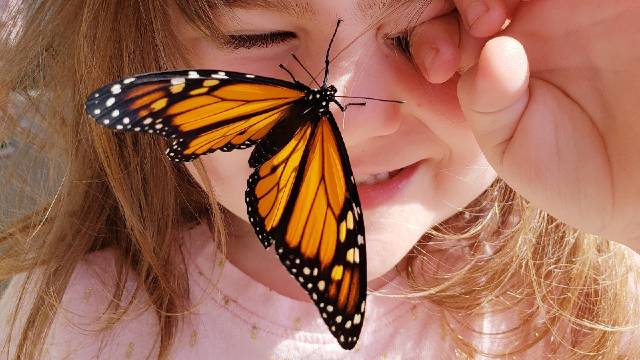By Carol Stiffler
They’re almost here.
Monarch butterflies are on their annual migration up from Mexico, where they spent the winter packed together in oyamel fir trees, waiting for spring.
According to the Journey North organization, which relies on human spotters to report their first adult monarch sighting of the year, the butterflies took flight in early to mid March. As of Saturday, May 23, they had been spotted as nearby as Midland, Michigan. That means we can expect to see them any day now.
I am eager to see them. They feel like friends by now. My first monarch memories are from my childhood, when my parents brought in a caterpillar and kept it supplied with milkweed so we could watch it transform into a chrysalis and, eventually, emerge as a butterfly.
What can be more amazing than that? These creatures begin as a tiny caterpillar, so small you could disturb them with a breath. They eat their egg shell as their first meal and then nibble tiny indentations into milkweed leaves. Over the next two weeks of their lives, they molt five times and become enormously fat. They wear yellow and black stripes and are perhaps not all that cute unless you are prone to loving them.
They spend their caterpillar lives clinging to milkweed plants with very sticky feet. They just want to eat, and poop, and they wouldn’t dream of flying.
Then one day, when they’ve had enough to eat, they make a dramatic life change. They create a sturdy silk button from the end of their bodies, and they let go. They literally dangle from that silk button – look, ma, no hands!
It’s the ultimate leap of faith. Those sticky little feet are suspended uselessly in air while the caterpillar dangles upside down for a whole day. Its final act as a caterpillar is to bulge out of its own skin, let a chrysalis harden around it, and then wait.
How in the world does that caterpillar morph into a giant butterfly with a dazzling orange and black wingspan? Why is that possible?
And yet, it is.
When the butterfly comes out of that chrysalis, it hangs around the scene for a while to dry its wings. And it’s not afraid of people yet. It would crawl right onto your finger if you gave it a chance.
For the past two summers, I raised monarch caterpillars and gave them a place to transform into butterflies in peace and safety. Raising them was gobs of work but immensely improved their chance of egg-to-butterfly survival. Left in the wild, studies show a monarch egg has just a 10 percent chance of ultimately producing a butterfly. Raised in safety, that number shoots up to 90 percent.
The monarchs do need our help. Monarch numbers have been dwindling over the years, as the butterfly falls victim to lost habitat in Mexico, and the loss of milkweed in northern zones. It’s a double-whammy. Activists are working on both fronts, trying to encourage milkweed planting everywhere and to preserve the tiny area where monarchs spend their winters.
Everyone can help, which is the best part. Unlike some environmental nightmares, like the islands of trash in the oceans that we literally can’t touch, we can plant milkweed for those caterpillars. We can protect areas rich with milkweed. We can plant flowers for pollinators – which includes monarchs – so the butterflies have food.
It’s a small thing, perhaps, all things considered. But monarchs are a beautiful piece of our great global puzzle, and without them, our puzzle is incomplete.
So I am watching for the first sprouts of milkweed along my road. I am waiting to spot my first monarch of the season – bound to be a very weary traveler. And it feels like waiting for old friends to come back home.







